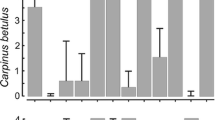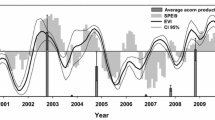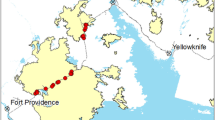Abstract
Tree growth is regulated by a combination of exogenous and endogenous factors. Such factors also interact with each other, complicating the understanding of causal links. IN particular, resource allocation is sensitive to reproductive investment, especially in masting species, which in turn is regulated by climatic variables. Both resource allocation and seed production patterns are also sensitive to tree age. This study aims to (1) evaluate the effects of tree age and local and regional climate on tree ring width and seed production by Spanish black pine (Pinus nigra Arn. ssp. salzmannii) forest in Cuenca Mountains (Spain), and (2) assess the relationship between seed production and secondary growth of Spanish black pine. Seed fall was estimated using 60 rectangular seed traps (40 × 50 × 15 cm) from 2000 to 2014, randomly distributed across the study area. Standardized tree-ring chronologies were calculated using a random sample of 106 trees stratified into three age classes (> 80 years; 26–80 years, and ≤ 25 years). Local climate data was obtained from a meteorological station, and regional climate data from the CRU-TS 3.1 dataset. Average seed production ranged over time from 2 to 189 seeds m−2 (coefficient of variation = 157%). We identified four masting years (2000, 2003, 2006, and 2014) using a classification based on percentile seed production. Seed production was regulated by climate of the previous 2–3 years, while tree growth responded to precipitation and temperature in the previous and current year. Independent of climate, high seed production had a negative effect on tree ring width and weakened climate growth relationships, indicating resource depletion. Tree age modulated climate sensitivity, increasing correlations between climate and tree-ring index in older trees. P. nigra has been showed to be a climate sensitive species with a bimodal masting behaviour, which should be taking into account for management purposes and silvicultural guidelines under climate change scenarios.







Similar content being viewed by others
References
Allen CD (2009) Climate-induced forest dieback: an escalating global phenomenon? Unasylva 231/232(60):43–49
Allen CD, Macalady AK, Chenchouni H, Bachelet D, McDowell N, Vennetier M, Kitzberger T, Rigling A, Breshears DD, Hogg EH (2010) A global overview of drought and heat-induced tree mortality reveals emerging climate change risks for forests. For Ecol Manag 259:660–684
Allen RB, Millard P, Richardson SJ (2017) A resource centric view of climate and mast seeding in trees. Progress in Botany. Springer, Berlin
Allué JL (1990) Atlas Fitoclimático de España. Taxonomías. MAPA. INIA. Colección Monografías INIA, no. 69, Madrid
Arista M, Talavera S (1996) Density effect on the fruit-set, seed crop viability and seedling vigour of Abies pinsapo. Ann Bot 77:187–192
Ascoli D, Vacchiano G, Maringer J, Bovio G, Conedera M (2015) The synchronicity of masting and intermediate severity fire effects favours beech recruitment. For Ecol Manag 353:126–135
Ascoli D, Vacchiano G, Turco M, Conedera M, Drobyshev I, Maringer J, Motta R, Hacket-Pain A (2017) Inter-annual and decadal changes in teleconnections drive continental-scale synchronization of tree reproduction. Nat Commun 8:2205
Béllard C, Leclerc C, Leroy B, Bakkenes M, Veloz S, Thuiller W, Courchamp F (2014) Vulnerability of biodiversity hotspots to global change. Glob Ecol Biogeogr 23:1376–1386
Benavides R, Rabasa SG, Granda E, Escudero A, Hódar JA, Martínez-Vilalta J, Rincón A, Zamora R, Valladares F (2013) Direct and indirect effects of climate on demography and early growth of Pinus sylvestris at the rear edge: changing roles of biotic and abiotic factors. PLoS ONE 8(3):e59824
Boisvenue C, Running SW (2006) Impacts of climate change on natural forest productivity—evidence since the middle of the 20th century. Glob Chang Biol 12(5):862–882
Candel-Pérez D, Linares JC, Viñegla B, Lucas-Borja ME (2012) Assessing climate-growth relationships under contrasting stands of co-occurring Iberian pines along an altitudinal gradient. For Ecol Manag 274:48–57
Castagneri D, Petit G, Carrer M (2015) Divergent climate response on hydraulic-related xylem anatomical traits of Picea abies along a 900-m altitudinal gradient. Tree Physiol 35:1378–1387
Chaves MM, Maroco JP, Pereira JS (2003) Understanding plant responses to drought—from genes to the whole plant. Funct Plant Biol 30:239–264
Coutts S, Cousins C, Yvonne Buckley L (2012) Reproductive ecology of Pinus nigra in an invasive population: individual- and population-level variation in seed production and timing of seed release. Ann For Sci 69(4):467–476
Creus J (1998) A propósito de los árboles más viejos de la España peninsular: los Pinus nigra Arn. ssp. salzmanii (Dunal) Franco de Puertollano-Cabañas sierra de Cazorla, Jaén. Montes 54:68–76
Dawson TP, Curran PJ, Plummer SE (1997) The potential for understanding the biochemical signal in the forest canopies using a coupled leaf and canopy model. In: Guyot A, Phulpin T (eds) Physical measurements and signatures in remote sensing (A). Balkema, Rotterdam, pp 463–470
de Luis M, Cufar K, Di Filippo A, Novak K, Papadopoulos A, Piovesan G, Rathgeber CBK, Raventos J, Saz MA, Smith KT (2013) Plasticity in dendroclimatic response across the distribution range of Aleppo Pine (Pinus halepensis). PLoS ONE 8:1–13
Del Cerro A, Lucas-Borja ME, Martínez García E, López-Serrano FR, Andrés-Abellán M, García-Morote FA, Navarro-López R (2009) Influence of stand density and soil treatment on the Spanish black pine (Pinus nigra Arn. ssp. salzmannii) regeneration in Spain. Invest Agric Sist Rec For 18(2):167–180
Development Core Team R (2008) R: a language and environment for statistical computing. R Foundation for Statistical Computing, Vienna
Fritts HC (1976) Tree rings and climate London. Academic Press, London
Fritts HC, Vaganov EA, Sviderskaya IV, Shashkin AV (1991) Climatic variation and treering structure in conifers: a statistical simulative model of tree-ring width, number of cells, cell wall-thickness and wood density. Clim Res 1(6):37–54
Greene DF, Quesada M, Calogeropoulos C (2008) Dispersal of seeds by the tropical sea breeze. Ecology 89:118–125
Hacket-Pain AJ, Cavin L, Friend AD, Jump AS (2016) Consistent limitation of growth by high temperature and low precipitation from range core to southern edge of European beech indicates widespread vulnerability to changing climate. Eur J For Res 135:897. https://doi.org/10.1007/s10342-016-0982-7
Harris I, Jones PD, Osborn TJ, Lister DH (2014) Updated high-resolution grids of monthly climatic observations—the CRU TS3.10 Dataset. Int J Clim 34:623–642
Herrera CM, Jordano P, Guitián J, Traveset A (1998) Annual variability in seed production by woody plants and the masting concept: reassessment of principles and relationship to pollination and seed dispersal. Am Nat 152:576–594
Holmes RL (1983) Computer-assisted quality control in tree-ring dating and measurement. Tree-Ring Bull 43:69–78
IPCC (2013) Climate Change 2013: The Physical Science Basis. Contribution of Working Group I to the Fifth Assessment Report of the Intergovernmental Panel on Climate Change. Cambridge University Press, Cambridge
Kelly D (1994) The evolutionary ecology of mast seeding. Trends Ecol Evol 9:465–470
Kelly D, Geldenhuis JA, James A, Holland EP, Plant MJ, Brockie RE (2013) Of mast and mean: differential-temperature cue makes mast seeding insensitive to climate change. Ecol Lett 16:90–98
Kerr G (2000) Natural regeneration of Corsican pine (Pinus nigra subsp. laricio) in Great Britain. Forestry 73:479–488
Koenig WD, Knops JMH (2000) Patterns of annual seed production by northern hemisphere trees: a global perspective. Am Nat 155:59–69
Linares JC, Tíscar PA (2010a) Climate change impacts and vulnerability of the southern populations of Pinus nigra ssp. salzmannii. Tree Physiol 30:795–806
Linares JC, Tíscar P (2010b) Climate change impacts and vulnerability of the southern populations of Pinus nigra subsp. salzmannii. Tree Physiol 30:795–806
Linares JC, Camarero JJ, Carreira JA (2009) Interacting effects of changes in climate and forest cover on mortality and growth of the southernmost European fir forests. Glob Ecol Biogeogr 18:485–497
Lloret F, Escudero A, Iriondo JM, Martínez-Vilalta J, Valladares F (2012) Extreme climatic events and vegetation: the role of stabilizing processes. Glob Change Biol 18:797–805
Lucas-Borja ME, Fonseca T, Parresol B, Silva-Santos P, García-Morote FA, Tíscar-Oliver PA (2011) Modelling Spanish black pine seedling emergence: establishing management strategies for endangered forest areas. For Ecol Manag 262:195–202
Lucas-Borja ME, Fonseca Fidalgo T, Linares JC, García-Morote FA, López-Serrano FR (2012) Does the recruitment pattern of Spanish black pine (Pinus nigra Arn. ssp. salzmannii) change the regeneration niche over the early life cycle of individuals? For Ecol Manag 284:93–99
Mace AE (1964) Sample size determination. Reinhold, New York
Mackay E (1926) El Pinus laricio Poir. y su aplicación a las repoblaciones forestales de la región mediterránea. I Congresso di Selvicoltura, Roma
Martín-Benito D, Cherubini P, del Rio M, Cañellas I (2008) Growth response to climate and drought in Pinus nigra Arn. trees of different crown classes. Trees 22:363–373
Martín-Benito D, Beeckman H, Cañellas I (2012) Influence of drought on tree rings and tracheid features of Pinus nigra and Pinus sylvestris in a mesic Mediterranean forest. Eur J For Res 132:33–45
Martínez-Vilalta J, López BC, Adell N, Badiella L, Ninyerola M (2008) Twentieth century increase of Scots pine radial growth in NE Spain shows strong climate interactions. Glob Change Biol 14:2868–2881
Matías L, Jump AS (2012) Interactions between growth, demography and biotic interactions in determining species range limits in a warming world: the case of Pinus sylvestris. For Ecol Manag 282:10–22
McDowell N, Pockman WT, Allen CD, Breshears DD, Cobb N, Kolb T, Plaut J, Sperry J, West A, Williams DG, Yepez EA (2008) Mechanisms of plant survival and mortality during drought: why do some plants survive while others succumb to drought? New Phytol 178:719–739
Nabuurs GJ, Lindner M, Verkerk PJ, Gunia K, Deda P, Michalak R, Grassi G (2013) First signs of carbon sink saturation in European forest biomass. Nat Clim Change 3:792–796
Ordóñez J, Retana J, Espelta J (2005) Effects of tree size, crown damage, and tree location on post-fire survival and cone production of Pinus nigra trees. For Ecol Manag 206:109–111
Ordóñez JL, Molowny-Horas R, Retana J (2006) A model of the recruitment of Pinus nigra from unburned edges after large wildfires. Ecol Model 197(3–4):405–417
Parker WC, Noland TL, Morneault AE (2013) Comparative mast seed production in unmanaged and shelterwood white pine (Pinus strobus L.) stands in central Ontario. New For 44(4):613–628
Pearse IS, Koenig WD, Kelly D (2016) Mechanisms of mast seeding: resources, weather, cues, and selection. New Phytol 212(3):546–562
Pearson RG, Dawson TP (2003) Predicting the impacts of climate change on the distribution of species: are bioclimate envelope models useful? Glob Ecol Biogeogr 12:361–371
Piovesan G, Schirone B (2000) Winter North Atlantic oscillation effects on the tree rings of the Italian beech (Fagus sylvatica L.). Int J Biometeorol 44(3):121–127
Redmond MD, Forcella F, Barger NN (2012) Declines in pinyon pine cone production associated with regional warming. Ecosphere 3(12):1–14
Resco de Dios V, Fischer C, Colinas C (2007) Climate change effects on Mediterranean forests and preventive measures. New For 33(1):29–40
Ruiz de la Torre (1979) Árboles y arbustos de la España peninsular. Escuela Técnica Superior de Ingenieros de Montes, Sección de Publicaciones, Madrid
Schauber EM, Kelly D, Turchin P, Simon C, Lee WG, Allen RB, Payton IJ, Wilson PR, Cowan PE, Brockie RE (2002) Synchronous and asynchronous masting by 18 New Zealand plant species: the role of temperature cues and implications for climate change. Ecology 83:1214–1225
Shestakova TA, Gutiérrez E, Kirdyanov AV, Camarero JJ, Génova M, Knorre A, Voltas J (2016) Forests synchronize their growth in contrasting Eurasian regions in response to climate warming. Proc Natl Acad Sci USA 113(3):662–667
Smith CC, Hamrick JL, Kramer CL (1990) The advantage of mast years for wind pollination. Am Nat 136:154–166
Tíscar PA (2002) Capacidad reproductiva de Pinus nigra subsp. salzmannii en relación con la edad de la planta madre. Invest Agrar: Sist Recur For 11:357–371
Tíscar PA (2007) Dinámica de regeneración de Pinus nigra subsp. salzmannii al sur de su área de distribución: etapas, procesos y factores implicados. Inv Agr: Sis Recur For 16:124–135
Tíscar P, Linares JC (2011) Structure and regeneration patterns of Pinus nigra subsp. salzmannii natural forests: a basic knowledge for adaptive management in a changing climate. Forests 2:1013–1030
Tíscar PA, Linares JC (2014) Large-scale regeneration patterns of Pinus nigra subsp. salzmannii: poor evidence of increasing facilitation across a drought Gradient. Forests 5:1–20
Vacchiano G, Motta R (2015) An improved species distribution model for Scots pine and downy oak under future climate change in the NW Italian Alps. Ann For Sci 72(3):321–334
Vacchiano G, Lonati M, Berretti R, Motta R (2013) Drivers of Pinus sylvestris L regeneration following small, high-severity fire in a dry, inner-alpine valley. Plant Biosyst 149:354–363
Vacchiano G, Hacket-Pain A, Turco M, Motta R, Maringer J, Conedera M, Drobyshev I, Ascoli D (2017) Spatial patterns and broad-scale weather cues of beech mast seeding in Europe. New Phytol 215(2):595–608
Vaganov EA, Hughes MK, Shashkin EA (2006) Growth dynamics of conifer tree rings: images of past and future environments. Springer, Berlin
Van Haverbeke DF (1990) Pinus nigra Arnold, European black pine. In: Burns RM, Honkala BH (eds) Silvics of North America, vol 1. Conifers. Agric. Handb. 654. U.S. Department of Agriculture, Forest Service, Washington, pp 395–404
Vidakovic M (1974) Genetics of European Black Pine (Pinus nigra Arn.). Ann For (Anali za Šumarstvo) 6:57–86
Wullschleger SD, Tschaplinski TJ, Norby RJ (2002) Plant water relations at elevated CO2—implications for water-limited environments. Plant, Cell Environ 25:319–331
Zang C, Biondi F (2015) treeclim: an R package for the numerical calibration of proxy-climate relationships. Ecography 38:431–436
Acknowledgements
This work was supported by Junta de Comunidades de Castilla-La Mancha (JCCM) [POII10-0112-7316]. Consejería de Agricultura (JCCM) provided the necessary support to carry out the field work. Authors also thanks PROFOUND COST-Action (FP1304).
Author information
Authors and Affiliations
Corresponding author
Rights and permissions
About this article
Cite this article
Lucas-Borja, M.E., Vacchiano, G. Interactions between climate, growth and seed production in Spanish black pine (Pinus nigra Arn. ssp. salzmannii) forests in Cuenca Mountains (Spain). New Forests 49, 399–414 (2018). https://doi.org/10.1007/s11056-018-9626-8
Received:
Accepted:
Published:
Issue Date:
DOI: https://doi.org/10.1007/s11056-018-9626-8




